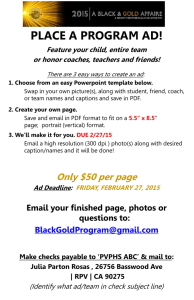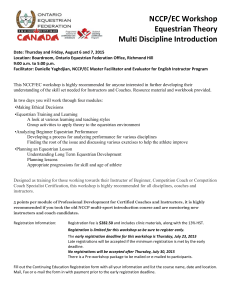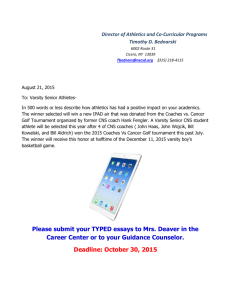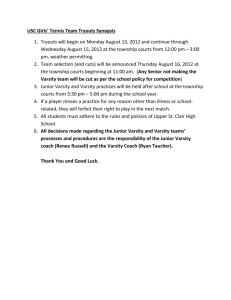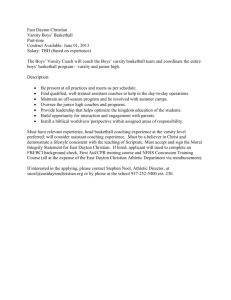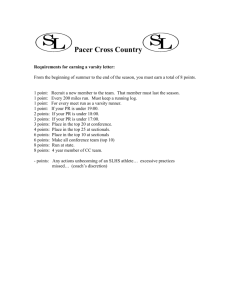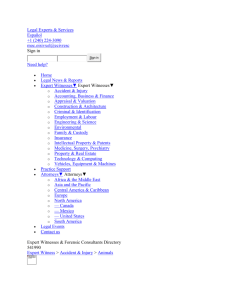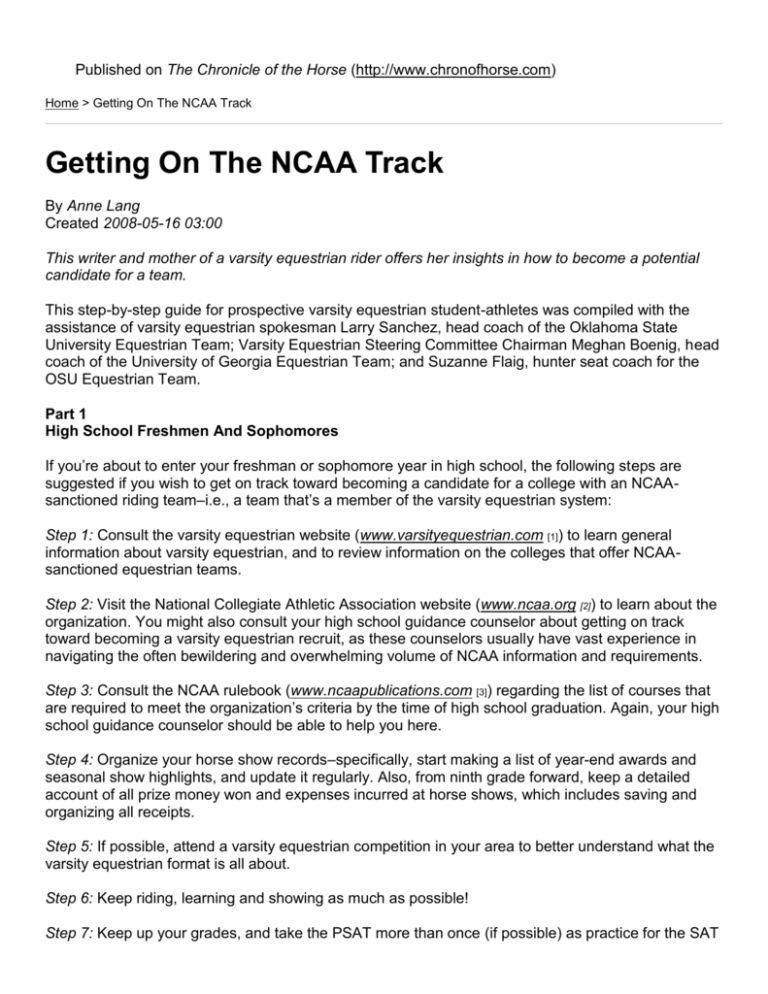
Published on The Chronicle of the Horse (http://www.chronofhorse.com)
Home > Getting On The NCAA Track
Getting On The NCAA Track
By Anne Lang
Created 2008-05-16 03:00
This writer and mother of a varsity equestrian rider offers her insights in how to become a potential
candidate for a team.
This step-by-step guide for prospective varsity equestrian student-athletes was compiled with the
assistance of varsity equestrian spokesman Larry Sanchez, head coach of the Oklahoma State
University Equestrian Team; Varsity Equestrian Steering Committee Chairman Meghan Boenig, head
coach of the University of Georgia Equestrian Team; and Suzanne Flaig, hunter seat coach for the
OSU Equestrian Team.
Part 1
High School Freshmen And Sophomores
If you’re about to enter your freshman or sophomore year in high school, the following steps are
suggested if you wish to get on track toward becoming a candidate for a college with an NCAAsanctioned riding team–i.e., a team that’s a member of the varsity equestrian system:
Step 1: Consult the varsity equestrian website (www.varsityequestrian.com [1]) to learn general
information about varsity equestrian, and to review information on the colleges that offer NCAAsanctioned equestrian teams.
Step 2: Visit the National Collegiate Athletic Association website (www.ncaa.org [2]) to learn about the
organization. You might also consult your high school guidance counselor about getting on track
toward becoming a varsity equestrian recruit, as these counselors usually have vast experience in
navigating the often bewildering and overwhelming volume of NCAA information and requirements.
Step 3: Consult the NCAA rulebook (www.ncaapublications.com [3]) regarding the list of courses that
are required to meet the organization’s criteria by the time of high school graduation. Again, your high
school guidance counselor should be able to help you here.
Step 4: Organize your horse show records–specifically, start making a list of year-end awards and
seasonal show highlights, and update it regularly. Also, from ninth grade forward, keep a detailed
account of all prize money won and expenses incurred at horse shows, which includes saving and
organizing all receipts.
Step 5: If possible, attend a varsity equestrian competition in your area to better understand what the
varsity equestrian format is all about.
Step 6: Keep riding, learning and showing as much as possible!
Step 7: Keep up your grades, and take the PSAT more than once (if possible) as practice for the SAT
and ACT. Academic accomplishment is an important factor in varsity equestrian recruiting.
Step 8: Alert your trainer of your interest in varsity equestrian schools, and give him or her information
on the varsity equestrian system so he or she can help and support you as you move through the
recruiting process.
Step 9: Know that while at any time you can send an e-mail or letter to a varsity equestrian coach,
make a phone call to that coach or go on a campus visit, a varsity equestrian coach is not permitted
to contact you during your freshman and sophomore years in high school.
Part 2
High School Juniors And Seniors And College Transfers
If you’re about to enter your junior or senior year in high school, or if you’re a current college student
planning to transfer to a varsity equestrian school, the following steps are suggested if you wish to
become a potential candidate for a college with an NCAA-sanctioned riding team:
Step 1: Review and follow all the steps outlined in Part I of this section.
Step 2: Register online with the NCAA Eligibility Center–formerly known as the NCAA Clearinghouse
(found at https://web1.ncaa.org/eligibilitycenter/common/ [4]). This is an important requirement.
Step 3: Explore all the colleges with links on the varsity equestrian website
(www.varsityequestrian.com [1]) and narrow down your choices of schools to which you desire to
apply.
Step 4: Go to the individual websites of the varsity equestrian colleges of interest to answer their
respective online equestrian athlete questionnaires. This preliminary step is important.
Step 5: Take the SAT and ACT in the fall of your junior year to allow plenty of opportunities for
possible retakes when dates are offered. When registering online for these tests, be sure to check the
box requesting that a copy of your test results be sent directly to the varsity equestrian colleges to
which you’d like to apply–and check the box requesting that a copy of your results be sent to the
NCAA Eligibility Center (which has its own designated code of 9999). These steps are both
mandatory if you wish to remain in the varsity equestrian application system.
Advice For Making A Riding Video
Step 6: Start compiling footage for a video of your riding
abilities. (More advice on that process in sidebar.)
Step 7: Create a one-page riding resume that includes
highlights from your horse show experience– including
year-end awards won and any other significant equestrian
honors or achievements earned during the past several
years. Also on this riding resume, list the names and
contact information for the trainers with whom you’ve
ridden during the past five years; the names of any guest
clinicians with whom you’ve worked; and your membership
ID numbers for the U.S. Equestrian Federation (and any
other applicable local, state, regional or national horse
show organizations to which you belong).
Step 8: Create a one-page non-riding resume that includes
any academic achievements, honors or awards; also list
your participation in volunteerism, extra-curricular activities,
leadership, community involvement, part-time jobs,
organizational memberships, etc., from ninth grade through
the present.
Step 9: Revisit the NCAA Rulebook
(www.ncaapublications.com [3]) and be sure to read
Chapter 12 (Amateurism), Chapter 13 (Recruiting) and
Chapter 14 (Eligibility). Along the way, familiarize yourself
with such terms as Divisions I, II and III; also Equivalency
Sports, Compliance, Official Visit, Unofficial Visit, Letter of
Intent, Signing Dates, Dead Periods, Walk-On Athletes and
Tryouts. These are all important terms to know.
Show examples of flatwork (including basic
dressage-type maneuvers such as circles, sitting
trot, halt transitions, lateral movements, nostirrup work, etc.) and jumping (including
footage of your best horse show rounds, but also
“practice” footage at your home barn such as
bending lines, equitation turns, etc.). As much as
possible, display how you ride a horse on the bit.
Wear breeches, tall boots and a snug-fitting
tucked-in shirt.
Show examples of riding at least three different
horses and indicate (with video
captions) each horse’s age and the current level
of its showing or training. Riding a variety of
horse types is suggested; for example, don’t be
afraid to show how you handle a green horse.
Use a DVD format, if possible, although VHS
format is acceptable at most schools. (Having
dubs made of a master DVD usually only cost a
few dollars each.)
Make sure to attach your name and all your
contact information to your video case, as well as
in an opening video caption.
Limit your video to no more than 15 minutes.
Don’t add background music, unless it’s
unobtrusively neutral and of moderate
volume.
Step 10: Consult the www.varsityequestrian.com [1] website for varsity equestrian schools that offer
summer riding camps. This experience offers a hands-on glimpse into what it’s like to ride at the
varsity level, even if the host school isn’t one in which you’d necessarily be interested in attending–
and you can pick up lots of helpful information too.
Step 11: Ask your high school guidance counselor to mail copies of your junior-year transcript to the
admissions offices and to the coaches at the varsity equestrian colleges of your choice. Be sure your
counselor mails a copy to the NCAA Eligibility Center as well. These transcripts must be sent directly
from your school and not from you.
Step 12: Compile a list of questions to ask varsity equestrian coaches during college visits.
Step 13: No later than the summer leading into your senior year, start mailing your packets of
personal information (cover letter, riding resume, academic resume and riding video) to coaches at
the varsity equestrian colleges that most interest you. You can mail these materials any time during
your junior year.
Step 14: The summer leading into your senior year, apply to the varsity equestrian colleges that
interest you. Many varsity equestrian colleges have a “rolling admissions” policy–so you might receive
news of your acceptance status in as little time as 30 days.
Part 3
Narrowing Down Choices
This list of elements to consider is presented with widely shared advice from varsity equestrian
coaches that first and foremost, a candidate should choose a college for its academic offerings and
overall appeal–and she should regard the existence of a varsity equestrian team simply as icing on
the cake:
• Academic programs and potential major/minor categories that fit your interests.
• A geographic location that’s appealing in climate and distance from home.
• An enrollment size that would feel comfortable to you.
“Do’s And Don’ts” For Writing A Cover
Letter
DO research the college’s team history before
you write the letter–and mention some specifics
in your letter that show the coach you’ve done
that research.
DO tell the coach why you are interested in her
his or her team, and why you’re interested in that
particular college.
DO make sure all of your contact information
(phone numbers, mailing address and e-mail) is
included in your letter.
• Annual tuition/room/board/textbook/ travel costs that fit
your family’s personal budget in case scholarship funds (of
any kind) do not become available.
• A thorough, personal visit to campus that leaves you with
a feel-good impression at all levels.
• A varsity equestrian team with a roster of individual
athlete profiles/histories that seem reasonably compatible
with your own riding and showing experience.
Part 4
Q&A: Going Beyond The Basic Steps
DON’T make the letter more than a few short
paragraphs.
Q: When a candidate has completed the equestrian athlete
questionnaire on the respective websites of the varsity
DON’T send the letter without double- checking equestrian colleges she might be interested in, should she
your spelling and grammar.
wait to see if she hears back from coaches? Or should she
go ahead and mail her video, riding resume, academic resume and cover letter to the coaches of the
schools she favors?
A: The candidate should send all of the above-mentioned personal materials, regardless of whether
she hears back from a varsity equestrian coach following submission of her questionnaire. Those
personal materials can be submitted to coaches any time during the candidate’s high school years,
although junior year is recommended. It’s also recommended that if a candidate hasn’t received a
response to her personal information within 14 days or so, she should follow up with an e-mail or call
to the coach (or coach’s assistant) to inquire about her current status. This not only confirms that the
candidate’s personal materials were routed to the right place, but also conveys her continued level of
interest to the coach.
Q: At what point in a candidate’s high school years is she advised to make initial contact with coaches
at varsity equestrian colleges to which she might wish to apply?
A: Summer is usually the optimum time for devoting time to reviewing videos and resumes. However,
any time during the candidate’s junior year is recommended for initial contact with varsity equestrian
coaches–either by e-mail, letter, phone call or campus visit–as long as those methods of contact are
initiated by the candidate and not by the coach. In terms of correspondence, it’s important to know
that e-mail and letters are the only NCAA-authorized means by which varsity coaches can respond to
a candidate’s query, prior to July 1 leading into the candidate’s senior year in high school–and the
original e-mail or letter must be initiated by the candidate. (Coaches are permitted to mail
informational/promotional packets to a candidate at any time after Sept. 1 of the candidate’s junior
year.) After July 1 leading into the candidate’s senior year, coaches are allowed to initiate personal
letters and/or make phone calls to a candidate (and to return phone calls, as well)–but the coaches
are limited to one weekly call per candidate. Text-messaging between coaches and candidates is not
permitted at any time during the recruiting process.
Q: Once a candidate has established contact with a varsity equestrian coach, should she continue to
update the coach on her riding progress and accomplishments? And if so, how often should she
submit updates?
A: After a candidate has submitted her video and resume, she may hear back from certain varsity
equestrian coaches who express interest in keeping her on their radar, so to speak. In those cases,
the candidate should continue to update those coaches (via e-mail) on her riding progress and
accomplishments–as well as letting coaches know of specific upcoming horse shows (and their
dates/locations) in which she will be competing, in case coaches want to watch her ride. A bi-monthly
or monthly update to coaches is suggested.
Q: At what point is it recommended that a candidate make a personal campus visit to a varsity
equestrian college in which she’s interested?
A: Under NCAA rules, if a candidate wishes to make an “unofficial” visit (i.e., the candidate covers all
of her own travel expenses), she is welcome to visit a varsity equestrian campus at any time during
her high school years–although junior year is recommended. On those unofficial visits, the candidate
is permitted to make an appointment to meet with the varsity equestrian coach, but the meeting must
take place on campus. However, if a candidate is formally invited by a varsity equestrian coach to
make an “official” visit (i.e., the college covers some or all of the candidate’s travel expenses), she
cannot make that official visit until after the first day of her senior year in high school. Under NCAA
rules, candidates are permitted to accept up to five official visits (to five different varsity colleges)
during their senior year. While a candidate may wish to make a campus visit during her high school’s
spring break, coaches caution that this may not always be the best time because varsity equestrian
colleges often are at the height of their spring competition season.
Q: When a candidate is planning a varsity equestrian campus visit, what other arrangements should
she consider making for the time she’s there?
A: On an unofficial visit, it’s always recommended that a candidate call ahead to schedule a campus
tour, a meeting with admissions, and an appointment with an academic advisor in the area(s) of study
that most interest her. On an official visit, usually the hosting coach will schedule all of those tours
and meetings for the candidate. Official visits only allow the candidate to remain on campus for up to
48 hours–so her time there needs to be mapped out efficiently and productively. But whether the visit
is unofficial or official, it’s always advisable to go while regular classes are in session to get a better
feel for the school, and to possibly have a chance to watch an equestrian team practice session.
Q: When a candidate visits a prospective varsity equestrian college, is it recommended that a parent
accompany her to meetings with the coach?
A: Typically, parents are encouraged to attend meetings between coaches and their daughter, but
they’re advised to simply listen rather than talk. This allows the coach to get a crucial feel for the
candidate’s personality and to allow the candidate an opportunity to ask her own questions. Toward
the end of such meetings, parents usually are welcome to ask any questions that might not have
already been addressed.
Q: How realistic is it to expect an offer of an athletic scholarship from a varsity equestrian college?
Q: Scholarship criteria vary from institution to institution, but it should be noted that not every varsity
equestrian athlete receives scholarship funds. A select few may receive full scholarships; some may
receive partial scholarships; and (depending on the size of a college’s roster) many varsity equestrian
athletes do not receive any monetary scholarships, but they might be eligible for partial (or full)
academic scholarships, either from the respective colleges or from outside entities. Also, at some
colleges, an athlete who starts on a varsity equestrian team as a walk-on might earn a scholarship
award over time as she continues to improve her riding, maintains a satisfactory academic standard
and exhibits a hard-work ethic toward the team.
Part 5
Q&A: Additional Advice
Q: What if you already have considerable experience showing in the hunter divisions, but little or no
experience in equitation?
A: Given the equitation-driven format of varsity equestrian, riders with a strong equitation background
almost always have a distinct advantage when it comes to being recruited for some of the top spots
on teams. Jumper experience also is helpful, as show jumping and equitation share some similar
elements. But a rider whose background is strictly in the hunters might exhibit an effective enough
basic equitation seat on her video that a coach will take a chance and sign her–or at least encourage
her to try out for a walk-on position.
Riders whose experience mostly consists of three-day eventing, dressage or Pony Club might also
manage to catch a coach’s eye, for the same reason. For those riders with little or no equitation
experience, some coaches suggest taking a lesson or two from a reputable equitation specialist.
Enlist someone to shoot film at those lessons, and then splice together a variety of highlights on a 15minute video. This can be submitted separately from the candidate’s original video, and it not only
demonstrates a candidate’s ability to learn and be effective at equitation, but also expresses the
candidate’s desire to work hard in this discipline.
Q: What if you live in states or regions where there’s little offered in the way of equitation or medal
classes at horse shows?
A: If a candidate’s primary goal is to land a varsity equestrian scholarship (and not just a walk-on
position), it’s recommended that she do whatever it takes to bolster her equitation experience and
skills. To that end, she may wish to purchase, lease or catch-ride an equitation horse and travel to the
longer-distance shows that offer those classes. Or, she might follow the advice (in the answer above)
of taking an equitation lesson and submitting a video of that lesson.
Q:What if you live in states or regions where there aren’t many USEF A-rated shows or your budget
limits you to riding exclusively in local, non-rated shows?
A: If a candidate has little or no experience on the A-rated show circuit, yet she’s been riding a wide
variety of horses at her barn (or catch-riding elsewhere), and has been successfully showing in the
upper-level divisions at non-rated competitions for a long time, there definitely are some varsity
equestrian teams where she might easily fit in as a walk-on–which comes with all the prestige and
perks of team membership, sans scholarship money. Over time, she might even work her way up
(through diligent effort and learning) to occasionally being tapped to ride in team competitions.
Q: What if you have earned significant prize money at the upper levels of show jumping–since this
could potentially nullify your NCAA amateur status?
A: Under NCAA rules, varsity equestrian recruits will be classified as amateurs only if the prize money
won at any given competition prior to college does not exceed the amount of a prescribed list of
expenses incurred at that competition—and those expenses are limited to entry fees, gasoline,
meals, lodging, stall, feed and hauling.
Candidates who compete in the more lucrative jumper divisions (or in the new USHJA Hunter
Derbies) are advised, from ninth grade forward, to keep well-organized records and detailed receipts
of their earnings and expenses. If a candidate is determined to seek a spot on a varsity equestrian
team in college, she’s urged to keep an ongoing close eye on the balance between those two
columns.
A candidate who competes at the more lucrative show jumping or hunter levels might consider the
viable option of requesting a reduced payout of prize money at any given show, in an amount that
doesn’t exceed her expenses. (Horse show secretaries are becoming acquainted with NCAA rules
regarding prize money, and most are willing to work with an exhibitor to adjust her payouts.).
If a candidate finds herself with an overall record of more prize money than expenses at the time she
applies for NCAA eligibility, she’s advised to consult the compliance officer at the college(s) of her
interest. These officers, who are on staff at all varsity equestrian schools, usually will work with
potential recruits on applying for reinstatement in the NCAA, if necessary.
Anne Lang
Intercollegiate
© 2005-2010, The Chronicle of the Horse, All rights reserved

